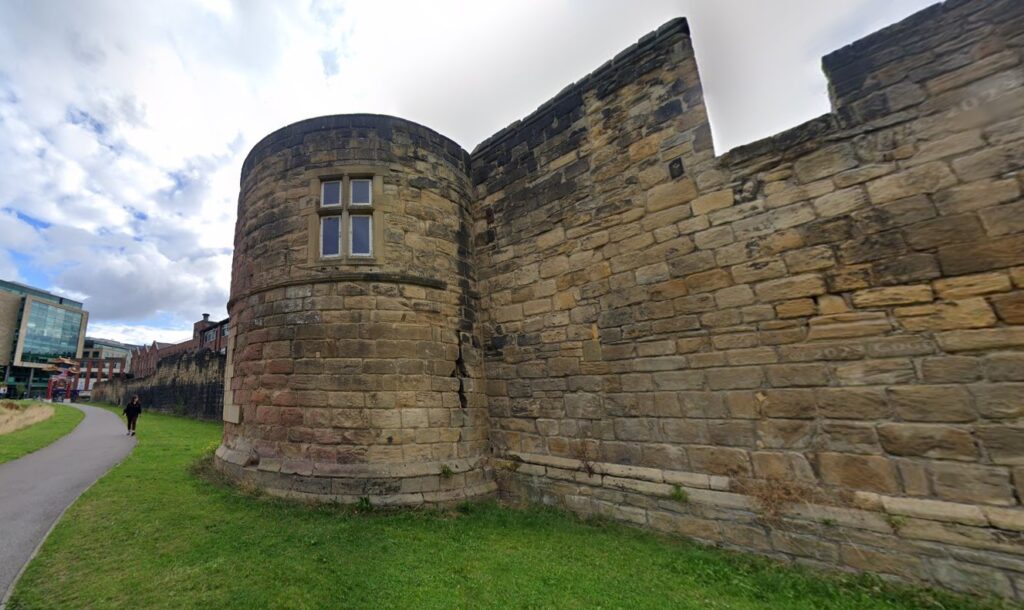
On June 16, 1964, Connie and Tom Pickard organised the first poetry reading at Morden Tower on Newcastle’s mediaeval town West Walls.
Over the next few years, against the odds, it became an international centre for poetry and one of the most iconic venues for poetry performances in Britain.
It played host to Allen Ginsberg, Ted Hughes and Lawrence Ferlinghetti, and inspired local poet Basil Bunting to write his celebrated work, Briggflatts.
- Read more: Calls for new government to create AI champion
- Read more: Review: Chitty Chitty Bang Bang at Theatre Royal, Newcastle
On June 16, the 60th anniversary of the first poetry reading at Morden Tower, a circus of poets and musicians will celebrate its remarkable legacy at the Tyneside Irish Centre for the Morden Tower @ 60 event, with all proceeds going to Alzheimer’s Research UK. More on this big bash later.
First, where can we discover more about Newcastle’s poetry revival in the 1960s? A new free exhibition, Voice from the Wall: Morden Tower and Newcastle’s Poetry Revival, at Newcastle University’s Robinson Library, is a good place to start.
This exhibition tells Morden Tower’s story through objects from the university’s Special Collections & Archives. It’s a real treasure trove.
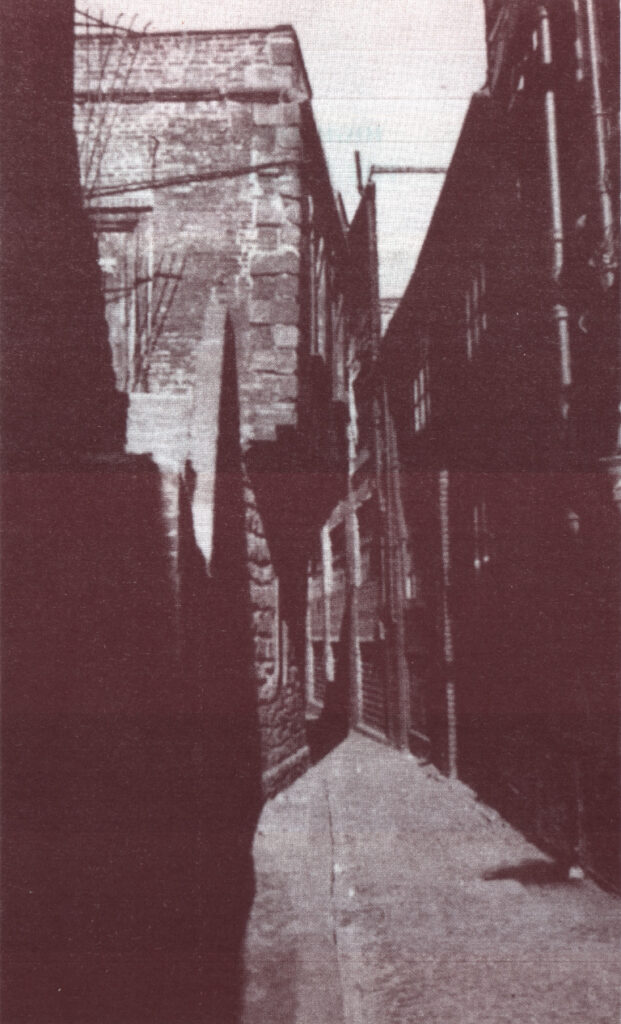
Morden Tower houses a turret room up steep stone steps on the 13th-century West Walls, only accessible down a dark alley, Back Stowell Street. Nowadays the kitchens of Chinese restaurants back onto this lane. In the 1960s, these buildings were noisome factories and workshops: an unlikely location for poetry events, and not for the faint-hearted.
Writers and activists Connie and Tom Pickard were inspired to set up a poetry venue and bookshop in Newcastle after visiting Edinburgh and enjoying its vibrant literary scene. The tower had no plumbing or electricity, but the rent was 10 shillings a week.
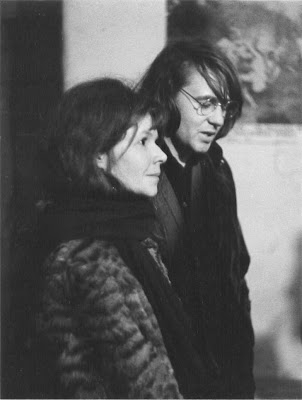
It was within 10 minutes’ walk of the Central Station, making it accessible to audiences and performers. If the gas supply was cut off, candlelight and the open fire added to the charm.
The first performer at the tower in June 1964 was Pete Brown, a songwriter who went on to pen tunes for Cream, and Jack Bruce as a solo artist. From the beginning a sense of the musicality of poetry, and the influence of American beat poets made events at the tower distinctive.
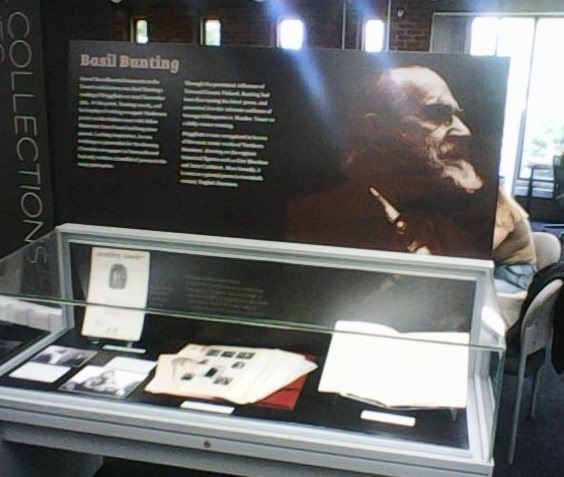
The next reading was given by Basil Bunting, a remarkable local poet in his sixties. A friend of Ezra Pound and WB Yeats, Bunting was now living in Wylam and not writing. Tom Pickard, however, managed to coax him out from Northumberland to perform at the tower.
Inspired by the warm reception the enthusiastic young audience gave him, Bunting’s literary spark was rekindled. A blue plaque on the tower today marks Bunting’s first performance of his celebrated autobiographical poem, Briggflatts, in 1965.
Many people were drawn to Bunting’s presence at tower events. One of the Voice from the Wall exhibition displays shows a photo of Allen Ginsberg chatting to Bunting in 1965. Bunting appears as an audience member in other photos.
Audiences were a mix of students and artists, writers and teachers, and young Geordies like Tom Pickard, in their teens and on the dole.

Connie Pickard describes what it was like for audiences inside the tower: “Once inside you did not sink into a cosy armchair but took your place on the floor, or you could sit on the stone ledge which runs round the walls. If you were lucky, you might get a cushion.”
Speaking about the buzz at tower events, Tom says: “For a long time, during the Sixties, it was a very exciting place to be. It broke down class barriers in a joyful mix of marijuana, alcohol, neat poetry and music.”
The diversity of writers who performed at Morden Tower over the years is extraordinary. Seamus Heaney, Allen Ginsberg, Roger McGough, Ted Hughes, Tony Harrison, Anne Stevenson, and Carol Ann Duffy have all read here.
High on the Walls, published in association with Bloodaxe Books in 1990 to mark the 25th-anniversary of readings at the tower, captures the spirit of the place.
I learned more reading at Morden Tower than I had at a hundred universities
Allen Ginsberg, poet and writer
Readings were always memorable. This tradition continued long after I arrived in Newcastle in 1989. It’s impossible to name them all here, but a sober Barry MacSweeney reading Pearl, a lyrical Tom Pickard, a surprising Bill Griffiths, a wise Linda France, and an exuberant Julia Darling, would all make my top 10 tower events.
One of the most striking photos in the exhibition shows Lawrence Ferlinghetti reading an event with Ginsberg and Gregory Corso in 1965. I’ve not seen this image before and yet it feels familiar.
Then I remember David Almond’s wonderful novel The Tightrope Walkers set in 1960s Newcastle. In it, teenager Dominic Hall gets a part-time job at Ultima Thule, the bookshop in the Handyside Arcade run by Tom Pickard and Tony Jackson. One evening, Dominic and his friend Holly Stroud go to a poetry reading.
“We saw Ginsberg and Ferlinghetti at the Tower. We sat in that dark candlelit room in the ancient city walls and sipped red wine and let the rhythms of New York and California sing in our northern brains.”
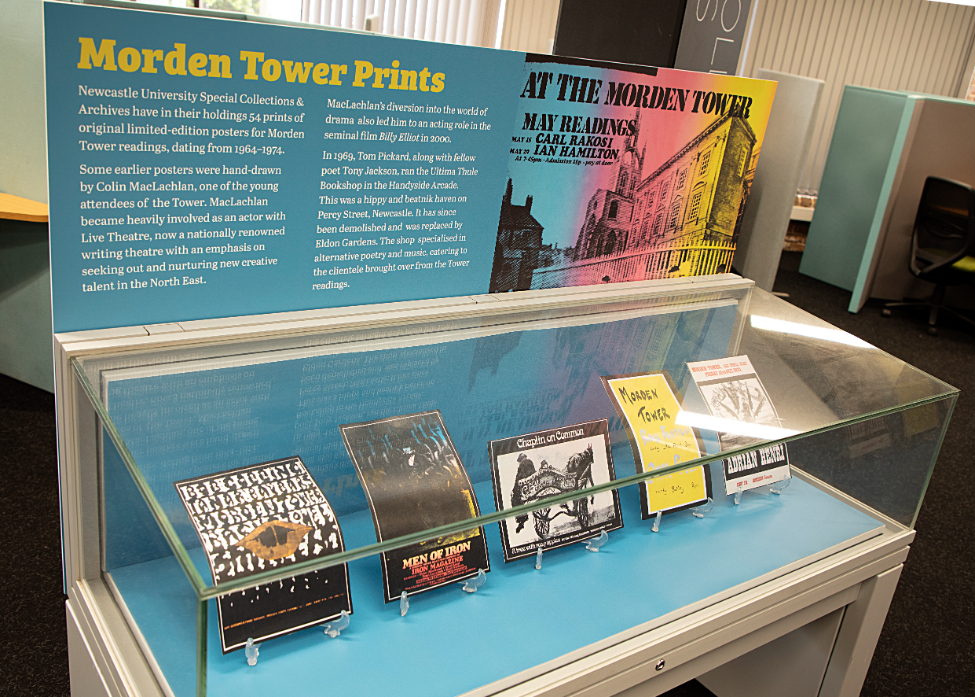
Another exhibition case shows posters promoting Morden Tower events, often with anarchic graphic design. Richard Hamilton, who taught at the Fine Art Department at King’s College, Durham (now Newcastle University), screen-printed many of the early posters.
We know he and art students, including Bryan Ferry, attended tower readings in the 1960s. I enjoy seeing the ‘Men of IRON’ and ‘Chaplin on Common’ posters here.
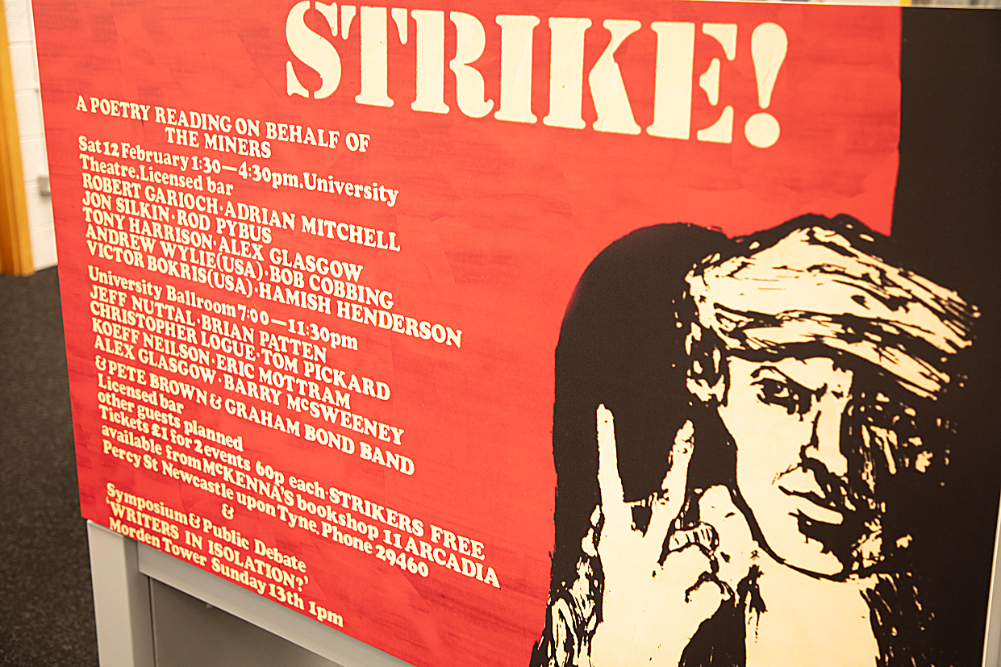
An impressive display case is about Morden Tower’s legacy. It includes the poster for the poetry reading Tom organised at Newcastle University in 1972 on behalf of striking miners. The first national miners’ strike against the Heath government lasted seven weeks from January to late February 1972.
The line-up for this event shows how actively engaged the whole poetry world was in national politics, and with miners’ struggles over pay and working conditions in their local communities.
Also on display is issue 1 of IRON magazine, launched by Peter Mortimer in 1973. This issue contains a long poem by Tom, America, and a wonderful article by Ginsberg titled Ginsberg in Newcastle about his 1965 reading at the tower, where he performed until after midnight.
“The most complete reading of my own written work that I have ever vocalised in one evening,” he wrote. “I learned more reading at Morden Tower than I had at a hundred universities.”
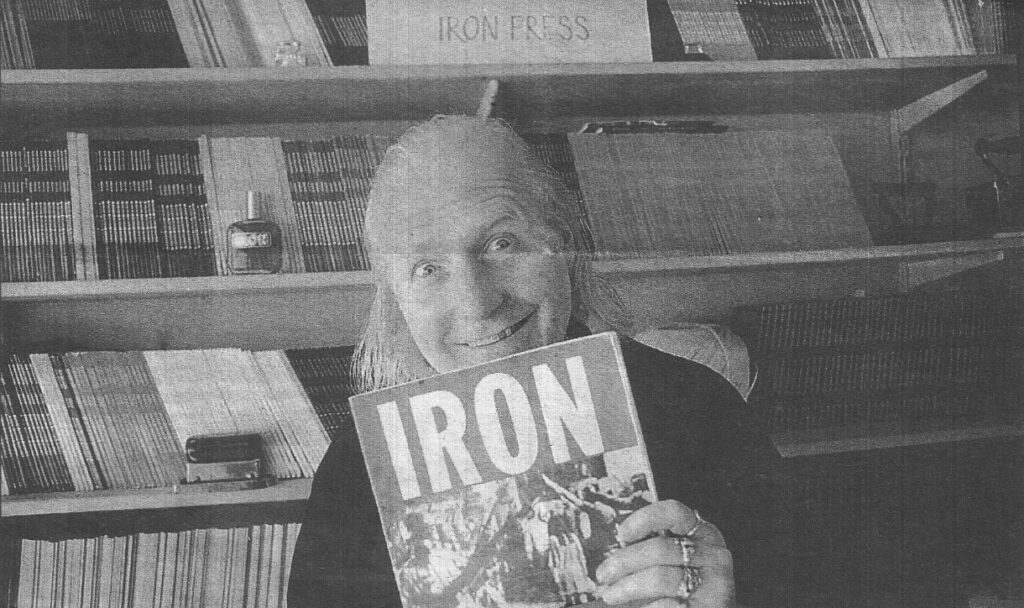
IRON Press is the region’s longest established literary publisher. It celebrated its 50th birthday in 2023 with a 12-hour poetry and music extravaganza at the Watch House in Cullercoats, which included contributions from Poet Laureate, Simon Armitage (first published in IRON Magazine in 1987), and Ian McMillan, presenter of BBC Radio 4’s The Verb, and a former assistant editor of the magazine.
Editor Peter Mortimer rounded off 2023 with a thoroughly deserved Lifetime Contribution to the Arts award at the North East Culture Awards.
Neil Astley founded the dynamic publishing house Bloodaxe Books in Newcastle in 1978, having organised readings and produced anthologies of new writing for Morden Tower. You will find gems from the Bloodaxe archives on display here, showing the extent of Astley’s sustained commitment to contemporary poetry publishing.
I’ve only scratched the surface of this accessible exhibition. Go and see it for yourself. It has been created imaginatively by archivist Rachel Hawkes, research students Maisie Drummond, Steve Kendall and William Kerr, and designer Mick Sharp.
While a young Bryan Ferry’s presence at Morden Tower in the 1960s may sound glamorous, when I speak to Tom Pickard, the struggle he and Connie faced putting on events makes their achievement miraculous.
- Read more: Nothing Trumps Donald hype
- Read more: Investing in more than just new homes
Tom explained: “The Northern Arts grants were never sufficient to keep us going, rather only enough — to quote Ed Dorn’s take on it — to encourage us to get into debt. We kept the tower going while often ourselves homeless and put under unbearable pressure by the dole and social security people.”
More grit than glamour.
If you visited the tower from the mid-1960s onwards, you would probably recall bumping into poet and editor Jon Silkin trying to sell you a copy of his quarterly literary magazine, Stand. Resistance was often futile.
He was, though, forcibly ejected from Newcastle University’s student union building in October 1965 for ‘pressure sales techniques’; as reported in The Courier student newspaper under a headline, ‘Silkin Removed From Union’.
At the invitation of Northern Arts, Jon Silkin moved Stand from Leeds to Newcastle in 1965, where it remained for over 30 years, co-edited with Lorna Tracy and others, until after Silkin’s death in 1997. Stand continues today at the University of Leeds.
Many people involved in tower readings over the years worked on the magazine, including Tony Harrison, Astley, Michael Blackburn, Peter Bennet and Brendan Cleary. As well as his poetry and Stand, Jon edited The Penguin Book of First World War Poetry and other anthologies. Stand was first based at 58 Queen’s Road in Newcastle, then 19 Haldane Terrace, and later 179 Wingrove Road.
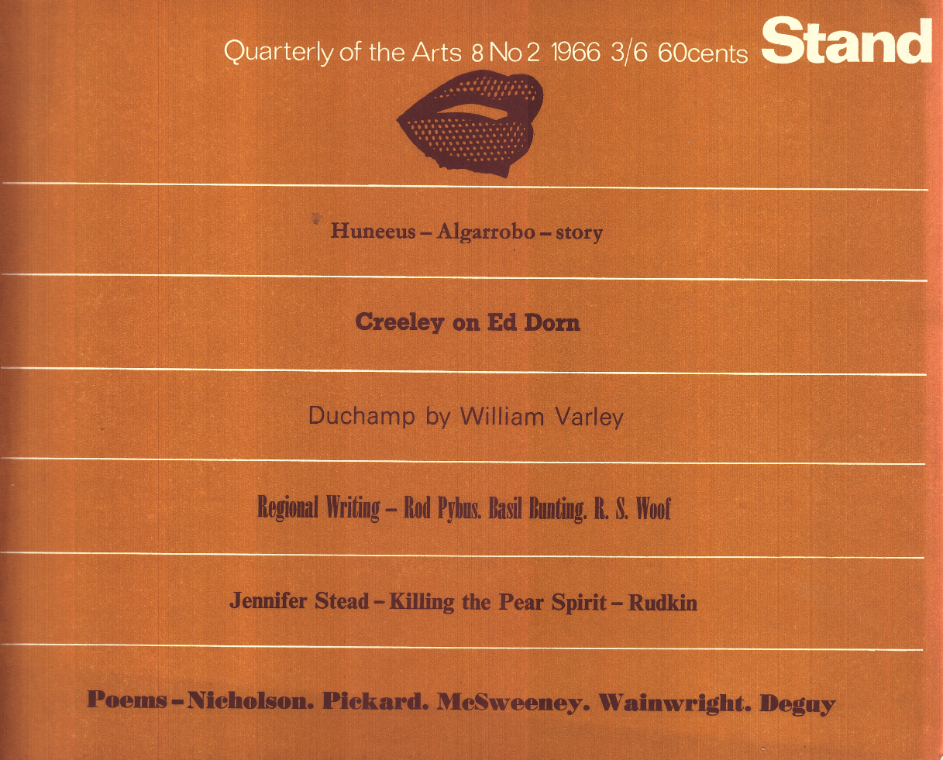
The summer 1966 issue of Stand is full of writers connected to Morden Tower. This issue features Tom Pickard and Barry MacSweeney’s first poems published in the magazine. It includes American authors Robert Creeley and Ed Dorn, and a historical account of North East poetry by Rodney Pybus.
It also features an illuminating article by RS Woof about Basil Bunting’s highly musical verse and Briggflatts; which had recently been published by Fulcrum Press in London.
Robert Woof taught English at Newcastle University from 1961 to 1992. During this time, he became the first director of the Wordsworth Trust in Grasmere, Cumbria.
As a young lecturer, Woof was drawn to the energy of Morden Tower readings, and they inspired the programme of events he established in Grasmere from the 1970s onwards.
Poets including Seamus Heaney and Harrison gave readings and became regular members of the Grasmere community. Robert strongly believed ‘the poetry of the past and the present are inextricably linked’. Visit Dove Cottage and the Wordsworth Museum today, and you will see the beauty and breadth of Woof’s imaginative genius.
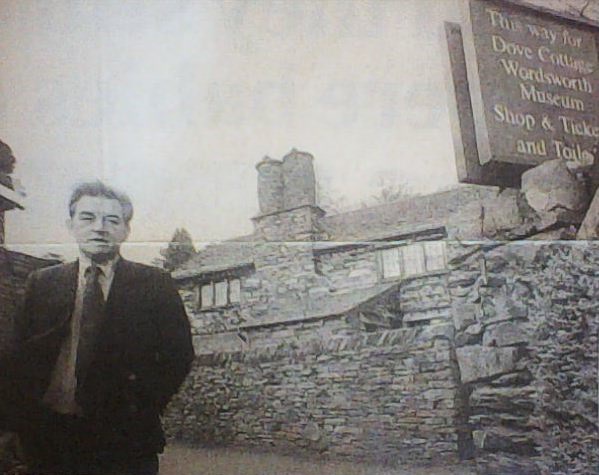
One of Woof’s students in Newcastle from 1967 to 1970 was John Wilkinson, from Canvey Island. He attended readings at the tower and became friends with Harrison, who had moved from Leeds to take up the first Northern Arts Literary Fellowship at the university. In his first year, Harrison kindly let Wilkinson and his wife Irene stay at his family’s home, while they looked for a flat in Newcastle.
After university, Wilkinson taught English for a time. Then he pursued his other passion, as musician Wilko Johnson: first in the band Dr Feelgood, then with Ian Dury and the Blockheads, and as a solo artist. Wilko’s memoir, Don’t You Leave Me Here, published in 2016, is an astonishing read.
Wilko’s love of literature and music, forged in Newcastle, continued throughout his life. As well as befriending Harrison, he was a close friend of writer Hugo Williams.
In the late 1970s, when Woof was building the Wordsworth Trust’s collection, a set of original Wordsworth manuscripts came up for sale. Woof was trying to raise funds, and Wilko organised a benefit gig in London, with his friend Lemmy from Motörhead. These literary fellows raised the money (and the roof). How rock’n’roll is that?
Today in Newcastle, Morden Tower stands sadly closed and neglected. It is unclear if it will open again.
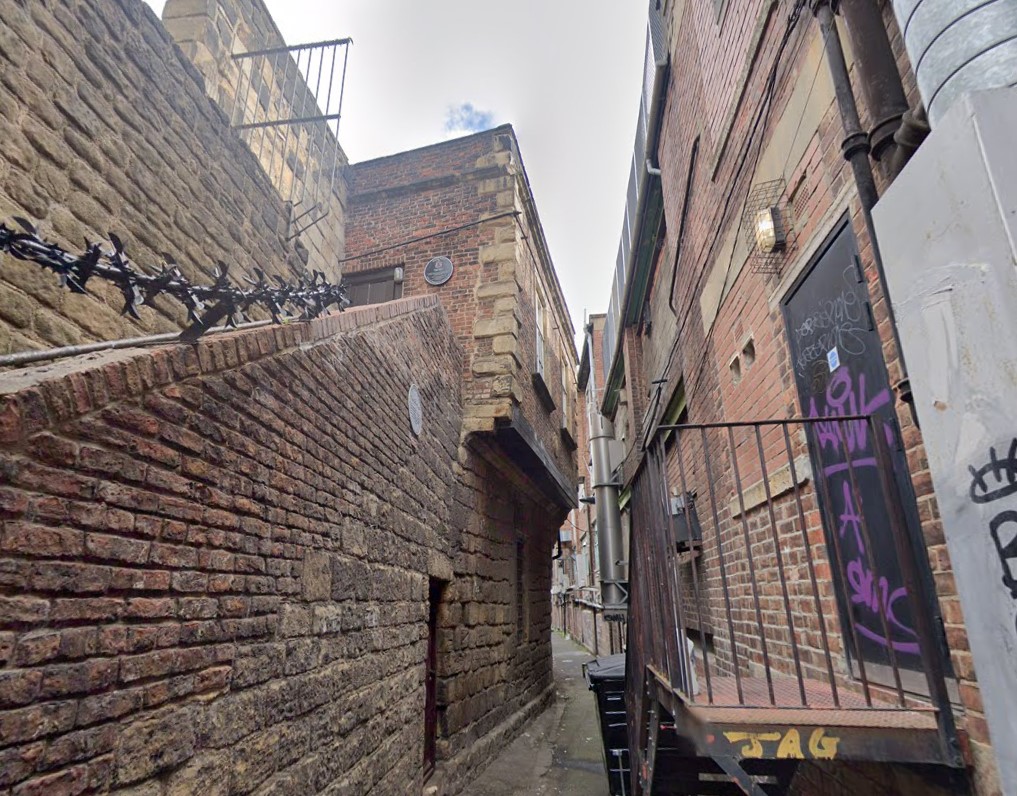
To the Pickards: thank you for your warmth and hospitality, for your brave creative vision, and for bringing the North East artistic community together at the tower over all these decades. I wonder how many life-changing, inspiring friendships and relationships you fostered down that dark back alley, and in the pub before and afterwards?
The Morden Tower @ 60 celebration takes place on Sunday, June 16, at the Tyneside Irish Centre, Newcastle, from 1pm to 7.30pm. Tickets are £10 (£5 unwaged) with all proceeds going to Alzheimer’s Research UK.
The line-up includes music from Paul Smith of Maxïmo Park, Kevin and Rosaleen Doonan of The Mighty Doonans, poetry from Cork’s Soundeye Festival collective and open mic performances to be announced.
There will be a Q&A with Tom Pickard in conversation with Alex Niven and the audience about the tower and Newcastle in the 1960s and 1970s, unseen film footage of Allen Ginsberg and Ed Dorn discussing Basil Bunting and Ezra Pound, and a display of Morden Tower event posters.
For more details and tickets to Morden Tower @ 60 visit the EventBrite website.
Voice from the Wall: Morden Tower and Newcastle’s Poetry Revival runs daily until July 7 at Newcastle University’s Robinson Library. Visit the website for more information.
Find Jack Arthurs at jackarthurs.bandcamp.com and on X @jackarthurs












2 thoughts on “Poetic power of Morden Tower”
Great article. The legacy of Morden Tower is utterly astonishing. Without it, we would not have been blessed with one of the finest poetical works of the 20th century: Briggflatts. Both it and Morden Tower deserve far greater recognition than they have received thus far.
Thanks Howard – glad you enjoyed it. It’s good for folk to have an opportunity to share and celebrate memories of the Tower. These amazing stories will live on.